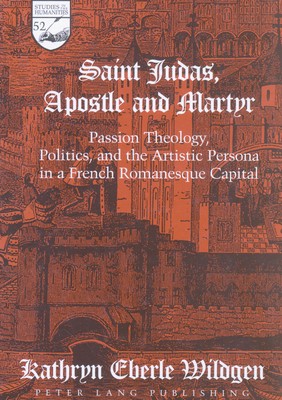
- We will send in 10–14 business days.
- Publisher: Peter Lang Inc., International Academic Publishers
- ISBN-10: 0820448745
- ISBN-13: 9780820448749
- Format: 15.2 x 22.9 x 1.3 cm, hardcover
- Language: English
- SAVE -10% with code: EXTRA
Saint Judas, Apostle and Martyr; Passion Theology, Politics, and the Artistic Persona in a French Romanesque Capital (e-book) (used book) | bookbook.eu
Reviews
Description
Between 1125 and 1135, it is generally agreed, a sculptor of genius usually referred to as Gislebertus carved a tympanum and a series of capitals for the cathedral dedicated to Saint Lazarus at Autun. The capital depicting the suicide of Judas is unique in the Romanesque repertoire both for its beauty of technique and for its execution of subject matter. The iconography is at once baffling and rich in possibilities of interpretation, which extend far beyond a simple image of a hanged man. One of the possibilities explored is that this is an image of a man realizing in extremis that he could and should have been remembered throughout history as Saint Judas, Apostle and Martyr, rather than as the paradigmatic traitor. There are objects in the image that demand - and receive - explanations, albeit tentative: the protuberance on Judas' back; the «strap» from which he is hanging; the position of his hands and feet. The interpretation is set firmly in its historical period, but the image is also discussed as an object whose significance transcends the time and the place in which it was conceived and produced.
EXTRA 10 % discount with code: EXTRA
The promotion ends in 20d.23:59:19
The discount code is valid when purchasing from 10 €. Discounts do not stack.
- Publisher: Peter Lang Inc., International Academic Publishers
- ISBN-10: 0820448745
- ISBN-13: 9780820448749
- Format: 15.2 x 22.9 x 1.3 cm, hardcover
- Language: English English
Between 1125 and 1135, it is generally agreed, a sculptor of genius usually referred to as Gislebertus carved a tympanum and a series of capitals for the cathedral dedicated to Saint Lazarus at Autun. The capital depicting the suicide of Judas is unique in the Romanesque repertoire both for its beauty of technique and for its execution of subject matter. The iconography is at once baffling and rich in possibilities of interpretation, which extend far beyond a simple image of a hanged man. One of the possibilities explored is that this is an image of a man realizing in extremis that he could and should have been remembered throughout history as Saint Judas, Apostle and Martyr, rather than as the paradigmatic traitor. There are objects in the image that demand - and receive - explanations, albeit tentative: the protuberance on Judas' back; the «strap» from which he is hanging; the position of his hands and feet. The interpretation is set firmly in its historical period, but the image is also discussed as an object whose significance transcends the time and the place in which it was conceived and produced.


Reviews